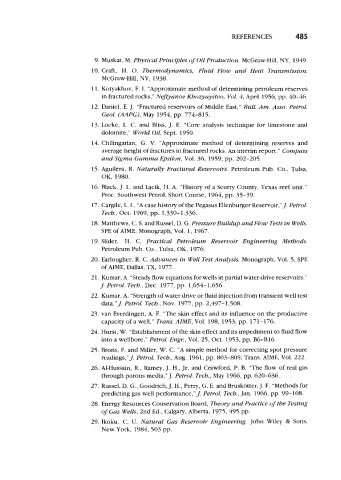Page 517 - Petrophysics
P. 517
REFERENCES
9. Muskat, M. Physical Principles of Oil Production. McGraw-Hill, NY, 1949.
10. Craft, H. 0. 7bermodynamics, Fluid Flow and Heat Transmission.
McGraw-Hill, NY, 1938.
11. Kotyakhov, F. I. “Approximate method of determining petroleum reserves
in fractured rocks,” Neftyanoe Khozyaystvo, Vol. 4, April 1956, pp. 40-46.
12. Daniel, E. J. “Fractured reservoirs of Middle East,” Bull. Am. Asso. Petrol.
Geol. (AAPG), May 1954, pp. 774-815.
13. Locke, L. C. and Bliss, J. E. “Core analysis technique for limestone and
dolomite,” World Oil, Sept. 1950.
14. Chilingarian, G. V. “Approximate method of determining reserves and
average height of fractures in fractured rocks. An interim report.” Compass
and Sigma Gamma Epsilon, Vol. 36, 1959, pp. 202-205.
15. Aguilera, R. Naturally Fractured Reservoirs. Petroleum Pub. Co., Tulsa,
OK, 1980.
16. Black, J. L. and Lacik, H. A. “History of a Scurry County, Texas reef unit.”
Proc. Southwest Petrol. Short Course, 1964, pp. 35-39.
17. Cargile, L. L. “A case history of the Pegasus Ellenburger Reservoir,”J Petrol.
Tech., Oct. 1969, pp. 1,330-1,336.
18. Matthews, C. S. and Russel, D. G. Pressure Buildup and Flow Tests in Wells.
SPE of AIME, Monograph, Vol. 1, 1967.
19. Slider, H. C. Practical Petroleum Reservoir Engineering Methods.
Petroleum Pub. Co., Tulsa, OK, 1976.
20. Earlougher, R. C. Advances in Well Test Analysis. Monograph, Vol. 5, SPE
of AIME, Dallas, TX, 1977.
2 1. Kumar, A. “Steady flow equations for wells in partial waterdrive reservoirs,”
J Petrol. Tech., Dec. 1977, pp. 1,654-1,656.
22. Kumar, A. “Strength of water drive or fluid injection from transient well test
data,” J. Petrol. Tech., Nov. 1977, pp. 2,497-1,508.
23. van Everdingen, A. F. “The skin effect and its influence on the productive
capacity of a well,” Trans. AIME, Vol. 198, 1953, pp. 171-176.
24. Hurst, W. “Establishment of the skin effect and its impediment to fluid flow
into a wellbore,” Petrol. Engr., Vol. 25, Oct. 1953, pp. B6-Bl6.
25. Brons, F. and Miller, W. C. “A simple method for correcting spot pressure
readings,”J Petrol. Tech., Aug. 1961, pp. 803-805; Trans. AIME, Vol. 222.
26. Al-Hussain, R., Ramey, J. H., Jr. and Crawford, P. B. “The flow of real gas
through porous media,” J. Petrol. Tech., May 1966, pp. 620-636.
27. Russel, D. G., Goodrich, J. H., Perry, G. E. and Bruskotter, J. F. “Methods for
predicting gas well performance,”J Petrol. Tech., Jan. 1966, pp. 99-108.
28. Energy Resources Conservation Board, The0 y and Practice of the Testing
of Gas Wells, 2nd Ed., Calgary, Alberta, 1975, 495 pp.
29. Ikoku, C. U. Natural Gas Reservoir Engineering. John Wiley & Sons,
New York, 1984, 503 pp.

